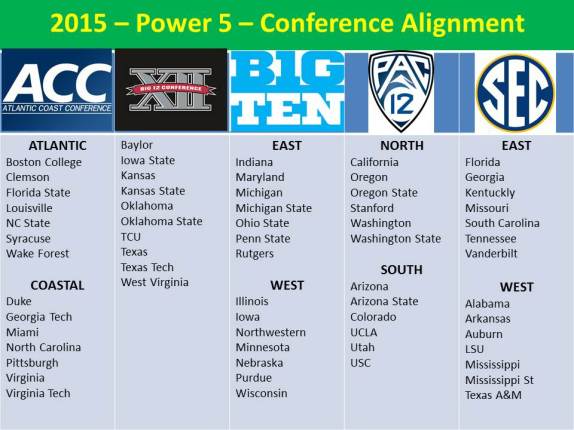All in all, not a bad year for college football head coaches; out of a total of 128 FBS football teams, only 15 will have a different head coach roaming the sidelines in 2015 than who they had to start the 2014 season. That is a very manageable 11.7% turnover.
Of those 15 schools with new head coaches:
• 9 teams are getting new, new Head Coaches
• 7 teams play in Power 5 Conferences
• 6 teams had winning records in 2014
• 2 bring in coaches from the NFL
• 1 brings in a Head Coach from a Division III program
• 1 brings in a Head Coach from a High School program
• 0 promoted from within

* First time Head Coach
** Head Coach at Div III
There are a few surprises, caused by the ripple effect of a few surprises. Although, it wasn’t a surprise that Bo Pelini was asked to depart the Nebraska job (some might question the soundness of that decision, but it was not a surprise that he was asked to step down), it was a mild surprise that Mike Riley, at 61 years of age, decided to fill that void. That move lead to an even bigger surprise when, after only 2 years, Gary Andersen decided to leave destination job, Wisconsin, for the spot Riley vacated in Oregon State. Time will tell whether or not Coach Andersen’s move was a good one for him, but, SOD is still shaking his head over that one. Patt Narduzzi fills in the spot at Pittsburgh ending that chain of events that put 3 teams on this list that might otherwise have not been there.
Jim Harbaugh comes back to the college football ranks after wearing out his welcome in San Francisco despite having some very successful years for that NFL franchise. Some suggest that Jim’s abrasive personality is better fit for college programs where the roster turns over every four to five years. By the time his players have grown tired of his antics, they are already moving along. There might be some validity to that. Without a doubt, however, Jim Harbaugh’s hiring makes the biggest splash and comes with the highest set of expectations. When you are the Head Coach at Michigan, splashes and high expectations are what you should get.
It will be interesting to see what Lance Leipold can do at Buffalo after having just a ridiculously successful time at Division III Wisconsin-Whitewater, amassing a record of 109-6 with 6 National Championships in 8 years. Buffalo is a tough job; you might have wondered if Lance could have held out for a better first-time FBS gig, but this might just prove to be a nice stepping stone for Coach Leipold.
Central Michigan was a late-comer to this party after Head Coach Don Enos bolted for a spot on the Arkansas staff just two weeks before signing the incoming class of freshmen. That makes it rather difficult finding a quality Head Coach this late in the process, but the Chippewas found an alum in John Bonamego willing to take a chance at the Head Coach’s position coming from the Detroit Lions as their Special Teams Coach.
Exactly 0 coaches were promoted from within to fill the Head Coach vacancy at their school. I guess that can be expected when a coach is asked to leave the program, that sometimes tarnishes the whole staff, but when a coach leaves on his own choosing, it is sad to see that there is no natural progression to fill in his spot. Nonetheless, several well deserving Offensive/Defensive Coordinators are getting a chance to fulfill their Head Coaching dreams, albeit in new surroundings. Only Pat Narduzzi, Michigan State’s Defensive Coordinator in 2014, steps into a Head Coaching position at a program in a Power 5 Conference. The rest of the new, new head coaches will learn their trade outside of the Power 5 with, no doubts, dreams of coaching their way into a bigger program some day.
Good luck gentlemen, we will see you in the fall.
